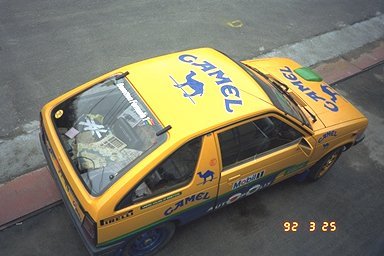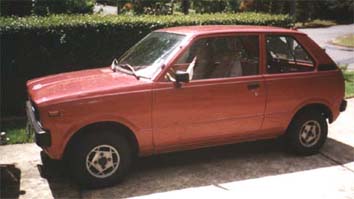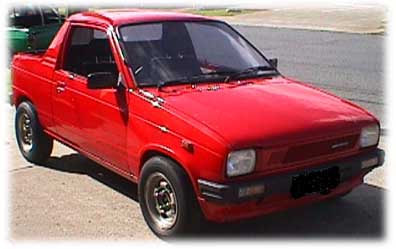
|
 The Mighty Boy owes its existence to a tradition of progressive Japanese government vehicle regulations whereby very small cars - 'K-class' or Kei Jidosha, escape excessive tax surcharge and inner-city parking fines. Strict size limits have ensured production of whole generations of midget-cars built for the Japanese market. To learn more about this type of car through-out the Suzuki range, click here.
Length: 300cm Suzuki's original Suzulight (1955-57) was the company's first attempt at car manufacture. Only 43 of these vehicles were built during the two years of manufacture. Proper production began in 1962 with the Suzulight 360 (2-cyl, 2-stroke, air-cooled, front wheel drive). A number of different versions were released including 2 & 3 door sedans and a wagon. Central to our theme, perhaps, is the Suzulight SP - a pick-up truck. The first Mighty Boy? In 1964, the 800cc Fronte was introduced with a 360cc version following in 1967 replacing the old Suzulight range. The Fronte 360 was more up to date than the Suzulights with a lightweight, 3-cylinder engine. There was even an 'SS' version, producing 36hp at 7000rpm. The Fronte series was updated in 1970, with a 500cc export version being introduced. April 1976 saw the Kei Jidosha laws change, allowing more engine displacement and slightly larger dimensions:
Width: 140cm (up by 10cm) Engine capacity: 550cc (up by a whopping 190cc)
The next event that leads inexorably to the introduction of the Mighty Boy was an overhaul of the Fronte range in 1979. This 4th generation of Frontes switched rear-engine to front mounted engine, and they were also known as Alto. There is still quite a number of these on Australian roads badged as Suzuki Hatch, with blanked rear side windows. The 800cc engine in these Australian-market Hatches were for export only, a 550cc engine conforming to the 'K'-car rules in Japan. The change from rear to front, transverse 4-stroke engines was a technical revolution for Suzuki that paved the way for future popular exports like Hatch, Mighty Boy, Swift, etc. The rear-engine Cervo in 1977 and the front-engine Fronte/Alto in 1979 were two models that would lead to the Mighty Boy. The third stage in this evolutionary process occurred in 1982 when Suzuki upgraded the Cervo to make it a front-engine car also. The second-generation Cervo was delineated from the Fronte/Alto range by being a purpose-designed sports model. This was the car that directly begat the Mighty Boy. The 1982 Cervo is the same vehicle as the Mighty Boy - except with a glass liftback instead of the ute bit on the back. Chassis, engine, etc. are the same - however, from 1983 onwards, the Cervo was released with a turbocharger (Cervo De Tomaso) which gave it 40hp at 6000rpm. Some Cervos may have been released with a factory-fitted supercharger.
Suzuki's Mighty Boy seems to have been in production from 1983 (at the earliest) to 1988 (at the latest). The rationale for the production of such a quirky vehicle is in doubt. Perhaps there was a legitimate need for a commercial courier vehicle in busy Tokyo streets. At any rate, the MB enjoyed a short popular run as a 'lifestyle' car in Australia (its only export market). As far as commercial applications go, there were reports here of "fleets" of Mighty Boys operating as pizza delivery trucks, the tray-floor being roughly equivalent in area to two family-size pizzas, with plenty of room behind the seats for a bottle of Coke and a couple of garlic-breads.
As a footnote, recent tests conclude that the Suzuki Mighty Boy is the fourth most unsafe car ever on Australian roads. One can only surmise how much unsafer it would be with a factory-fitted supercharger. The above document was kindly reproduced with the permission of the author, William Cattell. |
 In its new series of Frontes, Suzuki included a coupe version called Cervo (1977). This rear-engine 539cc fastback is a popular 'classic-car' in Japan and its reputation as a rustbucket might ensure classic status in the UK too, where it is known as the Whizzkid. Suzuki's introduction of the Cervo plays an important role in the development of the Mighty Boy, as we shall see.
In its new series of Frontes, Suzuki included a coupe version called Cervo (1977). This rear-engine 539cc fastback is a popular 'classic-car' in Japan and its reputation as a rustbucket might ensure classic status in the UK too, where it is known as the Whizzkid. Suzuki's introduction of the Cervo plays an important role in the development of the Mighty Boy, as we shall see. One of the endearing qualities of the Mighty Boy its stylishness, being derived from a well-designed car in the first place (the 1982 Cervo). Unlike its boxy Fronte/Alto/Hatch contemporaries, the Mighty Boy wedges slightly at the front, presenting a narrower and snarlier face. The windscreen sweeps and joins the roofline at a better angle. The notched 'ute' rear (as opposed to the Cervo) gives the MB an almost mid-engined 'Lotus Europa' look ('almost' being the operative word). And the side-windows have the same lines as the windows on a Triumph TR-7, if you look at them at just the right angle. (What a pity that it was never available with the Cervo's turbocharger!) The Mighty Boy's chromed "roofrack" and tray-rails are obviously a measure implemented to rigidise the body, given the absence of the Cervo's full-length fastback.
One of the endearing qualities of the Mighty Boy its stylishness, being derived from a well-designed car in the first place (the 1982 Cervo). Unlike its boxy Fronte/Alto/Hatch contemporaries, the Mighty Boy wedges slightly at the front, presenting a narrower and snarlier face. The windscreen sweeps and joins the roofline at a better angle. The notched 'ute' rear (as opposed to the Cervo) gives the MB an almost mid-engined 'Lotus Europa' look ('almost' being the operative word). And the side-windows have the same lines as the windows on a Triumph TR-7, if you look at them at just the right angle. (What a pity that it was never available with the Cervo's turbocharger!) The Mighty Boy's chromed "roofrack" and tray-rails are obviously a measure implemented to rigidise the body, given the absence of the Cervo's full-length fastback. Even though they were considered to be kind of a joke when first seen in Australia, the Mighty Boy gained credibility fairly quickly and there were stories of convoys of them heading north along the east coast - towing special little surfboard trailers. Today, a surprising number of people can identify the car despite its low volume production and scarcity. Its one-off singularity combined with its nonsensical name seems to have gained it some level of recognition and inner-city street-cred'. It's much rarer than VW Beetles, more reliable and easier to look after than a Fiat Bambino yet, somehow, stupider, and infinitely more stylish than a host of later 'K' class vehicles - like Subaru Fiori, Daihatsu Mira, Honda City etc. To drive a Mighty Boy today is to have the odd person come up and say how they always wanted one.
Even though they were considered to be kind of a joke when first seen in Australia, the Mighty Boy gained credibility fairly quickly and there were stories of convoys of them heading north along the east coast - towing special little surfboard trailers. Today, a surprising number of people can identify the car despite its low volume production and scarcity. Its one-off singularity combined with its nonsensical name seems to have gained it some level of recognition and inner-city street-cred'. It's much rarer than VW Beetles, more reliable and easier to look after than a Fiat Bambino yet, somehow, stupider, and infinitely more stylish than a host of later 'K' class vehicles - like Subaru Fiori, Daihatsu Mira, Honda City etc. To drive a Mighty Boy today is to have the odd person come up and say how they always wanted one.